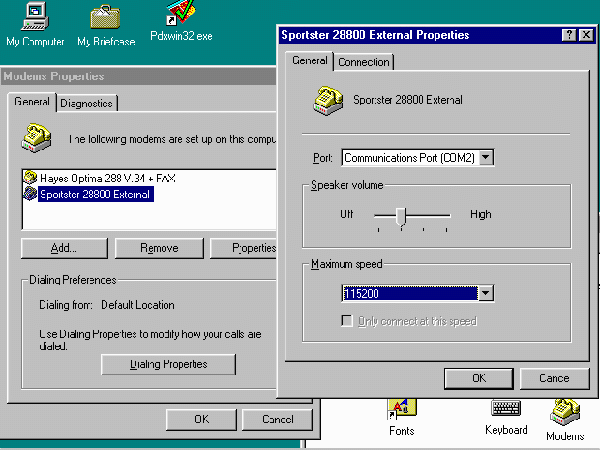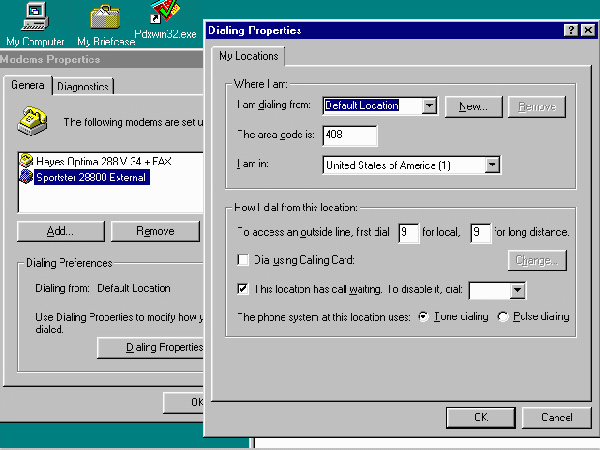General Modem Problems
Modems, among other reasons, account
for a large number of the "general" problems new subscribers
experience in setting up their connections. See
Modem Settings for the straight details
on configuring your modems. Among the most common modem-related
problems are:
- I can't connect to the network.
- I don’t get a dial tone.
- My connection to CNC worked great for a long time, but
suddenly started quitting.
- I have fewer problems dialing into other locations than
dialing into CNC. Why is that?
Your Windows 95 operating system
attempts to automatically set up and configure your modem when you
first attach it and run its modem setup program. In most cases, it
will do so without a hitch. In most situations, you should accept
Windows 95’s default modem settings, including the port,
Interrupt and IRQ port settings shown below. Your overall settings
should then be:
|
COM1
|
COM2
|
|
Interrupt: 3
IRQ Address: 3F8
Baud: 14,400 or higher
Data Bits: 8
Stop Bits: 1
Parity: None
Flow Control: Hardware (RTS/CTS)
|
Interrupt: 4
IRQ Address: 2F8
Baud: 14,400 or higher
Data Bits: 8
Stop Bits: 1
Parity: None Parity: None
Flow Control: Hardware (RTS/CTS)
|
If you find you are still having problems connecting after using
Windows 95's modem installation program, bear with us as we try going
through the connection steps, set out below:
To inspect your settings and check for possible modem problems,
follow these steps:
- Make sure your modem is turned on and that all of its wires
(for external modems) are securely fastened.
- Check the port settings to make sure your modem is properly
configured for the COM port to which it is physically connected.
To do this:
-
- Click on the Taskbar’s
 button. button.
- Select SETTINGS|CONTROL PANEL.
- Double-click the "Modems" icon.
- From the "Modem Properties" dialog box, click on the
PROPERTIES button to inspect or change your modem's settings,
as shown in the figure below.

- Click on the "General" tab if it is not already
selected.
- Make sure the Communications Port selected matches the one
to which your modem is connected. For most systems, this will
be "COM2" if your comptuer has two serial ports, and COM1 if it
does not (provided you do not have a serial mouse connected to
it).
- Set the speaker volume indicator sufficiently to hear it
dialing (greater than "off").
- Accept the "Maximum speed" setting default Windows 95
inserted unless you know it is incorrect. Note that your
modem's maximum speed may considerably exceed the baud rate
entered. This is because the effective data transmission rate
varies with data compression and line dynamics.
- Make sure the box next to "Only connect at this speed" is
unchecked.
- Click the "Connection" tab.
- Make sure the connection preferences are set at 8-N-1:
8 Data bits
No Parity
1 Stop bit.
- Check the box next to "Wait for dial tone before dialing."
- Click the "OK" buttons to exit out of these dialog boxes.
- For internal modems, you may need to remove your computer's
cover and make sure the modem card is snugly seated.
Other Reasons
- Other possible reasons for difficulties connecting to the
network include:
-
- Your modem or telephone lines are too close to other
electronic devices, possibly causing electro-magnetic
interference.
- You may have improper types of telephone wire or cables
(external).
- Your communications card (external) or modem card
(internal) may be defective.
- Your telephone wires or cables(external) may be plugged
into the wrong slots.
- A major earthquake may have damaged Concentric Network's
servers.
- You may not have properly installed your
communications/dialer software.
- Are you sure you are using the right password?
- Are you sure your account status is up to date?
Dialing problems
Dialing problems may show up when:
- My connection hangs just as I am logging to CNC.
- I get a dial tone, but no number dials.
- I get a dial tone and hear a number dialing, but it does
not connect me to CNC.
- My connection hangs just as I am logging in to CNC.
Phone calls are sometimes dropped due to line interference,
heavy traffic loads or momentary hardware failures. Heavier than
normal network loads also may cause your line to hang shortly
after you try to connect. If your call does not go through on the
first attempt, wait several minutes and try again.
If you still cannot connect, check your dialer settings
you had entered when you set up your Windows 95 "Dial-up
Networking." (see the
Configuring Your Dialer
section for greater details). To do this:
- From your Windows 95 desktop, click on the "My Computer"
icon.
- Double-click on the "Dial-UP Networking" icon.
- Double-click on the connection Entry Name you want to use
to connect to Concentric Network. This will display your dialer
window, entitled "Connect To."
- Make sure that your "User name", "phone number" (your
Local Access Number or CNC's
hourly 800 number: 1-800-991-4227), and "Dialing from" settings
are correct.
- Click on the "Dialing Properties" button to display the
dialing properties dialog box similar to the one shown below.

- Check to see if your "I am dialing from:" location, area
code and country are correct.
- Check to see if the "How I dial from this location"
settings are correct for:
-
- obtaining an outside line (enter a number, such as "9",
to get an outside line).
- using a calling card (check only if you are using one.
You will be prompted to enter your credit card information
upon checking the box).
- disabling call waiting while your computer is using a
telephone line which is otherwise used for voice calls
(check only if you have the "Call Waiting" feature. The
value is "*70" at most locations).
- Type of dialing. Most locations use "tone" dialing.
Unless you are sure your location uses "pulse" dialing,
leave it at "tone."
- Click the "OK" button.
- Make sure your modem and phone line are not in use by any
other program.
Outside line
problems
If your dialer failed to dial 9 to get an outside line, or if
it improperly inserted a 9 for an outside line when none is
needed, follow these steps to inspect or change these settings:
- From your Windows 95 desktop, click on the "My Computer"
icon.
- Double-click on the "Dial-UP Networking" icon.
- Double-click on the connection Entry Name you want to use
to connect to Concentric Network.
- Click on the "Dial Properties" button.
- Depending on which you want, make sure you have (or have
not) entered 9 (or other number, if appropriate) in the "To get
an outside line…" boxes.
- Click on the "OK" buttons to exit out.
Call waiting problems
If your connection is disrupted when another call comes in, it
may be due to call waiting interference. If you have this feature
on a phone line that you also use for your computer, you should
disable it while using your modem, as follows:
- From your Windows 95 desktop, click on the "My Computer"
icon.
- Double-click on the "Dial-UP Networking" icon.
- Double-click on the connection Entry Name you want to use
to connect to Concentric Network.
- Click on the "Dial Properties" button.
- Select the appropriate code for temporarily disabling the
call waiting feature. Consult your local phone company for the
appropriate code (in most cases, the default "*70," works
fine).
- Click on the "OK" button to exit out.
Winsock problems
If you get an error saying, "Can’t find Winsock.dll", as
soon as you try running Netscape Navigator or e-mail, chances are
that your TCP/IP software is improperly installed, or is not
installed at all. For details on setting it up, see the section on
"Configuring Your Dialer."
Long-distance problems
If your dialer inserted an area code or country code
inappropriately, follow these steps to inspect or change your
settings.
- From your Windows 95 desktop, click on the "My Computer"
icon.
- Double-click on the "Dial-UP Networking" icon.
- Double-click on the connection Entry Name you want to use
to connect to Concentric Network.
- Click on the "Dial Properties" button.
- Check to see if your "I am dialing from:" location, area
code and country are correct.
- If your location isn't on the list:
-
- Click New.
- Type a name for the location.
- Make sure your area code and country code are correct.
- Make sure the options for dialing from this location are
correct.
- Click on the "OK" button to exit out.
[Back to the Handbook
Home Page / Introduction to the
Web / Intro to Concentric
Network ]
[Connecting to
Concentric Network / Troubleshooting / Talk
to Us]
|